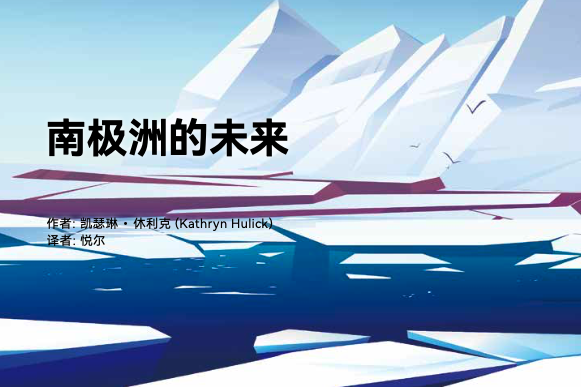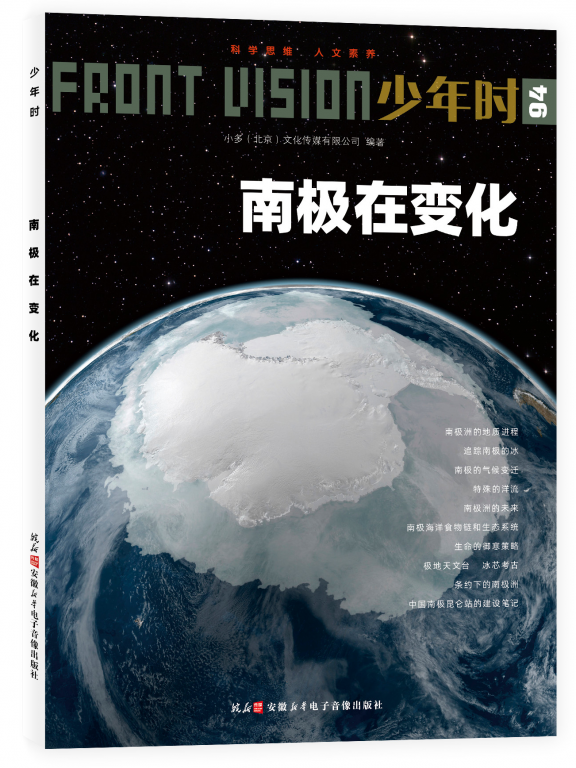This article appears in the October 2022 issue of Front Vision, an educational Chinese-language magazine for kids. It is reproduced here with permission.

The Future of Antarctica
Cliffs of blue-white ice rise high over the dark, cold sea. Penguins and seals dive in the waves while seabirds wheel in the sky. In the summer, the sun approaches the horizon but never completely sets, so brilliantly colored sunrises and sunsets last many hours. Welcome to Antarctica. “It’s just so beautiful, so majestic, so overwhelming,” says Cristina Mittermeier, a photographer for National Geographic. “You feel like you’re part of something much bigger.” Steve Rintoul, an oceanographer at CSIRO in Hobart, Australia, who has visited Antarctica dozens of times, agrees. “I feel very lucky that I get to spend part of my life in such an amazing place,” he says.
As part of Rintoul’s research, he uses scientific models to predict what Antarctica will be like in the future. Will it stay as pristine and beautiful as it is now? What will it be like there for people who visit many decades in the future? That depends on the choices we make now. If climate change continues to worsen, Antarctica will be a very different place in 2070. The weather, oceans, and wildlife will all change drastically. However, if we act now to slow down climate change and also work to protect Antarctica from human activity, then the icy continent will appear much the same in the future.
The future of Antarctica—and the rest of the world—is in our hands.
Corks on a Bottle
Human activity emits lots of extra greenhouse gases, especially carbon dioxide (CO2). These emissions are already warming the climate. We’re already experiencing many problems caused by climate change. Sea levels are rising. Dangerous weather events, including heat waves, fires, and hurricanes, are also becoming more common.
The Intergovernmental Panel on Climate Change (IPCC) puts out regular reports on how the climate is changing and what people should do about it. If people, companies, and governments around the world make the right choices, we could limit global warming to between 1.5°C to 2°C.
What if we fail? Antarctica may seem like the last place we’d need to worry about, since no people live there year-round. However, it turns out that the fate of this icy, remote world is directly tied to the fate of the rest of the planet. “Changes there affect the rest of the globe,” says Rintoul. That’s mainly because of Antarctica’s ice. As this ice melts, sea levels rise around the world.
Right now, most of Antarctica’s ice is trapped in the ice sheet covering the Antarctic continent. It’s held there thanks to ice shelves. These are huge, thick slabs of floating ice that surround the edges of Antarctica. Ice shelves act like corks on a bottle. As long as they stay frozen, all of the ice in the middle of the continent stays trapped there, like the liquid inside a bottle. The rocks of the continent prevent this trapped ice from melting.
Floating ice shelves melt from the bottom as warm ocean water gets underneath them. This water may come from currents that are warmer than usual due to climate change. In addition, melting ice can create flows in ocean water that carry warm water to the bottom of the ice even without any currents around. In the future, these ice shelves may also melt from the top as warmer weather occurs. The melted water would flow into any nearby cracks, widening them, and eventually breaking the ice apart.
If ice shelves melt or crack too much, they will break off or collapse. This is like the cork popping off. Trapped ice will flow toward the sea, melting as it goes. This is a point of no return— the process will continue for thousands of years, pushing sea levels higher and higher.
Rising sea levels aren’t the only problem caused by melting, breaking ice shelves. All the fresh water that these shelves release into the ocean will alter world weather patterns. Right now, ocean currents help carry heat around the planet. They move due to differences between hot and cold as well as salty and fresh water.
Adding a bunch of fresh water will slow down this circulation, reported Nicholas Golledge and his colleagues in a 2019 research paper. Golledge is a glacier expert at the Antarctic Research Centre at Victoria University of Wellington in New Zealand. This slowing will most likely cause cold places and seasons to get colder and hot ones to get hotter. Extreme weather events will become more common and more damaging. “The thing that surprised me most was the scale of climate impact from actually a small amount of ice loss,” Golledge said, “You don’t need to lose much ice from the ice sheet before you see tangible effects on the climate.”
We can’t put the cork back in the bottle—once ice shelves break, they are not going to reform. And many ice shelves are already quite weak.
Warmer, Wetter, and Less Wild
In a 2018 study, Rintoul and a team of other scientists described what Antarctica could be like in 2070 if the climate warms by 3.5°C. They describe a scenario in which one quarter of the volume of Antarctica’s ice shelves has been lost. The Venable, Crosson and Dotson ice shelves would collapse between 2040 and 2050, and the Thwaites would fall in 2060.
The lack of ice would lead to fewer krill, a tiny critter that many ocean animals feed on. Krill hide under ice and also feed on algae that grows there. When krill populations drop, salps take up residence instead. Salps are clear animals that look a bit like tube-shaped jellyfish but are actually related to sea cucumbers.
Above the water, the weather would be warmer and windier. “Parts of Antarctica will be so warm that it rains instead of snows for part of the year,” says Rintoul. In the summer, grasses would grow to cover some parts of the continent. People would be a much more common sight here. They may visit just to see the sights or to fish or mine resources. They would bring along invasive plants and animals that alter Antarctica’s ecosystems, making its wildlife more similar to that of the rest of the world.
Populations of penguins, sea birds, and seals would suffer from all of these changes. People and wildlife living far from Antarctica would suffer too. The collapse of so many ice shelves around the continent would contribute to a global sea level rise of around half a meter (1.5 feet) between 2000 and 2070. Huge parts of many of the world’s biggest coastal cities would be underwater. They include Osaka, Japan; Alexandria, Egypt; Rio de Janeiro, Brazil; Shanghai, China; Miami, United States of America; and others. Sea level would continue to rise over time, even if the climate stabilizes.
This is just a hypothetical scenario, not a prophecy. Still, all of these changes are likely if people don’t do enough to limit emissions and curb climate change.
What if the world succeeds in keeping climate change to below a 2°C increase? If this happens, and if people band together to protect Antarctica from too much tourism, fishing, and mining, then the continent could stay much the same as it is now. It would be a bit warmer and snowier. Some ice shelves would be lost. But “It remains a wilderness with its own unique ecosystems,” says Rintoul.
Modeling the Future
How do Rintoul and other scientists know what is likely to happen to Antarctica in the future? They use computer models to make these predictions. A computer model is a simplified, digital version of a process that happens in the real world. To make a model, researchers take a physical process and describe it with mathematical equations. For example, a frozen glacier may seem solid. But it actually flows extremely slowly, mostly due to its heavy weight. Mathematical equations can describe how quickly all the different bits of ice in a glacier will flow. Unfortunately, the math of how fluids move is extremely complicated. So a glacier model must take shortcuts that approximate the motion. Scientists often look at past changes to glaciers to help make these approximations.
Another equation can describe how the weight of the glacier changes. When snow falls on top of a glacier and sticks there, the glacier gets bigger and heavier. As water flows underneath it and melts ice, the glacier gets smaller and lighter. The difference between these two processes is called the mass balance. Modeling the flow and mass balance of a single glacier can help a researcher predict how that glacier will change over time.
To discover the future of Antarctica, scientists must model more than just individual glaciers. They must model weather, ocean currents, geography, ice shelves, and more. All of these systems are closely connected. “What happens in the atmosphere affects what happens in the ocean, and the atmosphere and ocean affect the ice,” says Rintoul. “You can’t understand one without understanding the others.” So, he says, “We try to represent all these things interacting at once.”
In addition, scientists can’t just model these systems on and around Antarctica—they must model the entire Earth. “Things that happen near the equator in the atmosphere kick off wind systems that ultimately affect how much snow falls on Antarctica,” says Rintoul.
A model that does all of this is called an Earth System Model. It must start with actual weather, ocean, and ice data from the real world. For Antarctica, these data often come from satellites that observe the continent from above. These satellites help track how ice and ice shelves there are changing. Scientists and meteorologists also place instruments into the ocean and into the air to take regular measurements. Ocean profiling floats, explains Rintoul, are devices that drift with the current. Every ten days, they pop up to the surface, taking measurements as they rise. Then they sink down and start the process over again.
To build an Earth System Model, scientists turn the interactions within and among systems into sets of equations. Then they feed in the data they have collected. Heat exchange is one type of interaction. If warm air blows over a cold ocean, the ocean will warm up and the air will cool as heat transfers from one to the other. “We have an equation that can represent how rapidly that happens,” says Rintoul. “We can use that to predict forward in time.” The model starts with an air and ocean temperature measured now, then uses the heat exchange formula to discover what the temperature of each will be in the future. Models that predict the future of Earth’s climate include equations for heat exchanges as well as numerous other processes, such as cloud formation, glacier movement, the greenhouse effect, and much more.
Researchers add human behavior into these models as well. When they feed different levels of greenhouse gas emissions into the same model, they end up seeing how much warming could result in each case. Then they can look at what has happened to all the other parts of the model. This is how we know what Antarctica could be like in 2070 after 1.5 or 3.5 degrees of warming.
Chunks of Space
Running all of these equations and figuring out how they interact demands a huge amount of computer power. To simplify things, models divide the planet into chunks. Just as a camera divides an image into separate pixels of color, an Earth System Model divides the atmosphere, ocean, and landscape into blocks of space. The smaller the blocks, the more precise a prediction you can get but the longer it will take for the model to run. “Right now, the chunks in most of these models are about one hundred kilometers on a side,” says Rintoul. “The entire Panama Canal would fit into one chunk. Even using chunks this big, it can still take several months for a model to complete one run. And you need to do many runs to make sure the model is working correctly.”
There isn’t one correct way to build a model. Different researchers have taken different approaches to predicting Antarctica’s (and Earth’s) future. Rintoul says that twenty-five to fifty different Earth System Models exist. Since no model is perfect, looking at the results from several different models can help scientists understand how likely a certain future may be. That’s exactly what Rintoul and his team did for their 2018 paper. They consulted many different models to make their predictions.
Since 2018, of course, things have changed. Rintoul says that the impacts of climate change are being felt “sooner than we had anticipated.” That means we will likely have to work even harder to keep Antarctica frozen and wild far into the future. But this is still a goal we must strive for. “We need to act soon,” says Rintoul. With new laws and treaties to slow climate change and protect Antarctica, that continent as well as the rest of the world will be a better place in the future.

